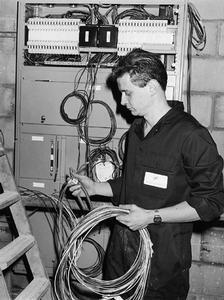The conditions of apprenticeships also varied geographically – apprentices in the south had a legal agreement dictating the rights and obligations of both parties, while those in the north had a much less formal arrangement.
This situation did little to enhance the reputation of the electrical contracting industry as the standards of work were as variable as the standards of training. Indeed, such was the fear of unsafe installations that this lack of clearly defined standards of workmanship was seen as holding back the spread of electricity through the country.
Duty to apprentices
As early as 1902, less than a year after the Association's formation, the then chairman Henry Bland asserted that the Association had a duty to support the education of apprentices and to promote excellence in electrical work. This statement led to an ongoing interest in the education of electricians and, from the start, companies applying for membership had to show that their workforce had the necessary skills and experience.
From here it was a logical step to play a role in developing the skills of those operatives and in 1915 the Association became involved in the examining of electrical installers with the City & Guilds of London Institute. As an extra incentive, the Association introduced an awards scheme to reward the high fliers of the time.
Along with a number of other initiatives, the involvement with education eventually led to the National Apprenticeship Scheme in 1944, following on from the 1944 Education Act. Operated by the ECA and the Electrical Trades Union (ETU), the scheme required that all apprentices be registered and, as a result, the widespread use of casual labour declined. At the same time, the education of electrical apprentices became more standardised, providing extra reassurance to the industry's customers.
In 1967 the Joint Industry Board (JIB) was founded to provide a forum for discussions between the employers and the union on wages and conditions, That same year, the Construction Industry Training Board was set up with a brief to guide the training of apprentices throughout the whole construction industry. Funding for this came from a system of grants and levies and the Association worked hard to influence the allocation of funds to ensure that the electrical industry got its fair share.
While the nature of funding was changing, so were the ways in which the apprenticeships were being run. By 1965 apprentices had to obtain at least the City & Guilds 51(A) certificate in electrical installation practice before they could hold craft status.
The result of this was that the competence of apprentices could be tested before craft status was awarded – the first time this had been possible.
The 1965 Apprenticeship Agreement was replaced in 1970 by the JIB training scheme, which required that all apprentices be indentured and that their training be monitored. Particularly significant was the ban on site recruitment that accompanied this, eliminating the use of casual labour for electrical work and ensuring the move to JIB-graded operatives.
In 1983 there was to be an important change in the perception of apprenticeships, as the new JIB training scheme altered the emphasis from age to achievement. At around the same time, a student traineeship was developed, in association with the Manpower Services Commission.
Training continued to go from strength to strength and in 1989 the Association decided to leave the CITB to work with the union in establishing a training body just for the electrical industry. The result was JT Limited, responsible for maintaining standards at colleges in England and Wales and distributing government funds.
At around this time, the government was transferring responsibility for funding from the Department of the Employment to the Training and Enterprise Councils (TECs). JT Limited had to negotiate with all 82 of these, while also redeveloping the Apprentice Training Scheme to meet the requirements of the new National Vocational Qualifications (NVQs).
In response to these changes, the ECA formed the Electrical Installation Engineering Industry Training Organisation (EEITO), which gained National Training Organisation status in 1997. Later that year it changed its name to National Electrotechnical Training (NET).
As well as identifying current and future needs, NET develops occupational standards as a basis for NVQs. Looking to the future, its next main goal is to establish a career structure in electrical contracting that is capable of taking people on at all ages and from all backgrounds and helping them to build in a career in the electrical contracting industry.
Milestones
1902 Henry Bland calls for support of training1915 William Rawlings becomes examiner for City & Guilds
1944 National Apprenticeship Scheme formed
1967 CITB established
1970 JIB grading scheme introduced
1983 Training scheme restructured to reduce emphasis on age
1989 ECA leaves CITB to form JT Limited.
1997 EIEITO gains National Training Organisation status and changes name to NET.
Light, radio waves, and many other forms of electromagnetic radiation do not always travel at 186,272 miles per second. They only travel at that speed in a perfect vacuum. When moving through the air, these forms of radiation must travel slower. How many consultants does it take to change a light bulb? I'll have an estimate for you a week from Monday.
William Robert Rawlings

Source
Electrical and Mechanical Contractor



















